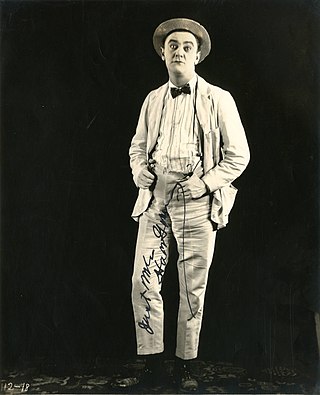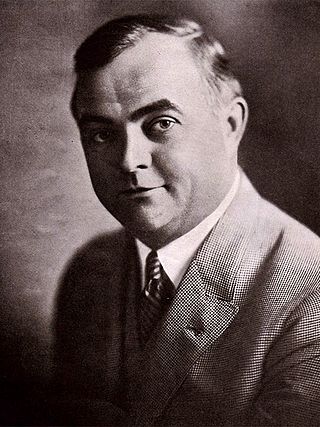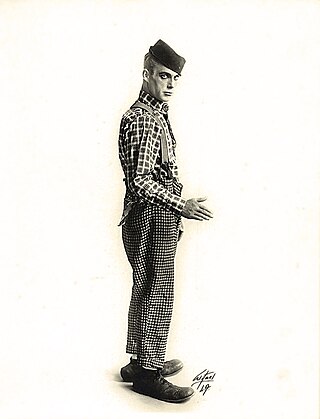
The Keystone Cops are fictional, humorously incompetent policemen featured in silent film slapstick comedies produced by Mack Sennett for his Keystone Film Company between 1912 and 1917.

Mack Sennett was a Canadian-American producer, director, actor, and studio head who was known as the "King of Comedy" during his career.

The Tramp, also known as the Little Tramp, was English actor Charlie Chaplin's most memorable on-screen character and an icon in world cinema during the era of silent film. The Tramp is also the title of a silent film starring Chaplin, which Chaplin wrote and directed in 1915.

Educational Pictures, also known as Educational Film Exchanges, Inc. or Educational Films Corporation of America, was an American film production and film distribution company founded in 1916 by Earle Hammons (1882–1962). Educational primarily distributed short subjects; it is best known for its series of comedies starring Buster Keaton and the earliest screen appearances of Shirley Temple (1932–34). The company ceased production in 1938, and finally closed in 1940 when its film library was sold at auction.

Ford Sterling was an American comedian and actor best known for his work with Keystone Studios. One of the 'Big 4', he was the original chief of the Keystone Cops.

Robert P. Dunn was a comic actor who was one of the original Keystone Cops in Hoffmeyer's Legacy.

Slim Summerville was an American film actor and director best known for his work in comedies.

Alice Howell was a silent film comedy actress from New York City. She was the mother of actress Yvonne Howell.

Eldon Raymond McKee, also credited as Roy McKee, was an American stage and screen actor. His film debut was in the 1912 production The Lovers' Signal. Over the next 23 years, he performed in no less than 172 additional films.

Harry Peter Gribbon was an American film actor, comedian and director known for The Cameraman (1928), Show People (1928) and Art Trouble (1934). He appeared in more than 140 films between 1915 and 1938. Many of his films from this era have been lost.

Glen W. Cavender was an American film actor. He appeared in more than 250 films between 1914 and 1949.

Fred Mace was a comedic actor during the silent era in the United States. He appeared in more than 150 films between 1909 and 1916. Mace worked for Mack Sennett at Keystone Studios. Shortly after he left, Roscoe Arbuckle, who had appeared in a few pictures at Keystone with Mace, took over as Sennett's lead comedic actor.

Fatty and the Broadway Stars is a 1915 American short comedy film directed by and starring Fatty Arbuckle.

The Pullman Bride is a 1917 American silent comedy film directed by Clarence G. Badger and starring Gloria Swanson.

The L-KO Kompany, or L-KO Komedies, was an American motion picture company founded by Henry Lehrman that produced silent one-, two- and very occasionally three-reel comedy shorts between 1914 and 1919. The initials L-KO stand for "Lehrman KnockOut".

Elgin Lessley was an American hand-crank cameraman of the silent film era—a period of filmmaking when virtually all special effects work had to be produced inside the camera during filming. Though Lessley worked earlier with Roscoe "Fatty" Arbuckle, and later with Harry Langdon, he is best known for the groundbreaking effects he produced with Buster Keaton, who dubbed him "the human metronome" for his ability to crank consistently at any requested speed.

Al St. John (1893–1963) was an American comic actor who appeared in 394 films between 1913 and 1952. Starting at Mack Sennett's Keystone Film Company, St. John rose through the ranks to become one of the major comedy stars of the 1920s, though less than half of his starring roles still survive today. With the advent of sound drastically changing and curtailing the two-reel comedy format, St. John diversified, creating a second career for himself as a comic sidekick in Western films and ultimately developing the character of "Fuzzy Q. Jones", for which he is best known in posterity.

Harry Watson Jr., also known as Harry B. Watson, was an American actor and comedian. Before his Vaudeville, Broadway and film careers, he was a clown for Ringling Bros. and Barnum & Bailey Circus. Among his Broadway shows were the musical Tip-Toes and five editions of the Ziegfeld Follies.

Luke the Dog (1913–1926) was an American Pit Bull Terrier that performed as a recurring character in American silent comedy shorts between 1914 and 1920. Some claim he was a "Staffordshire Bull terrier" or "American Staffordshire bull terrier but neither of these breeds existed until the 1930's, and this is why his name nickname was Luke the pitbull.

Norma Nichols was an American silent film actress. She appeared in 42 films between 1914 and 1922. She appeared in several of Larry Semon's films. She was the sister of actress Marguerite Nichols who married actor, director, and producer Hal Roach.




















